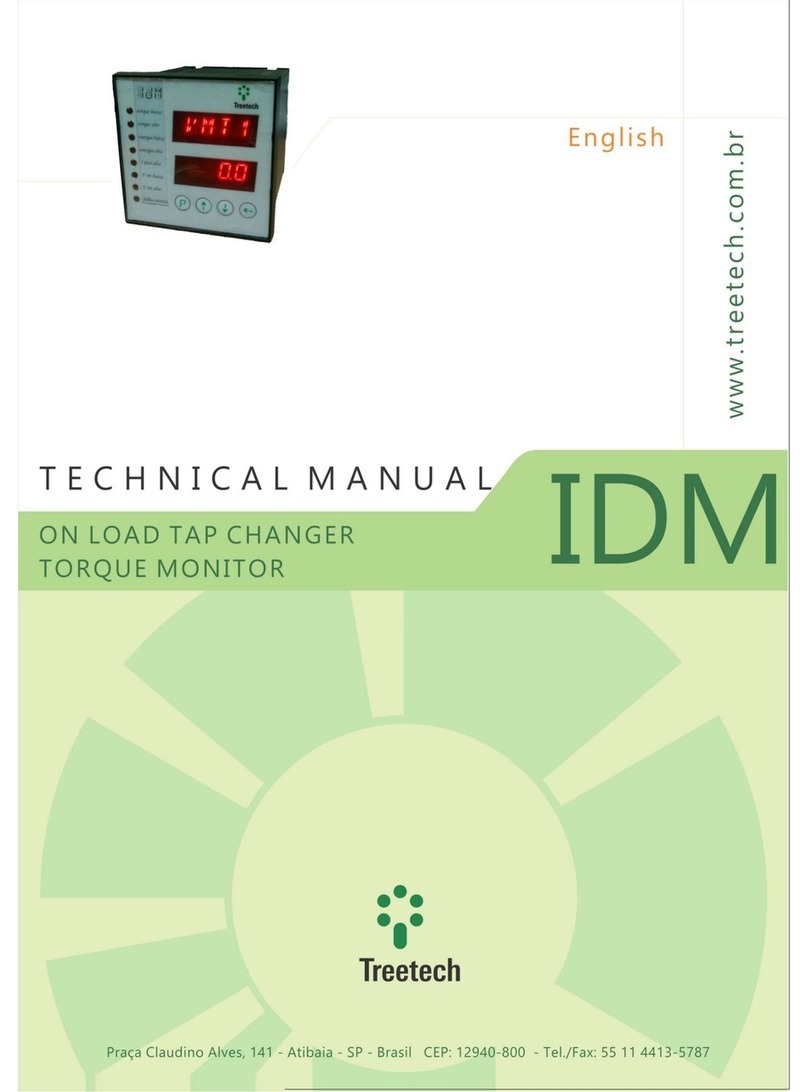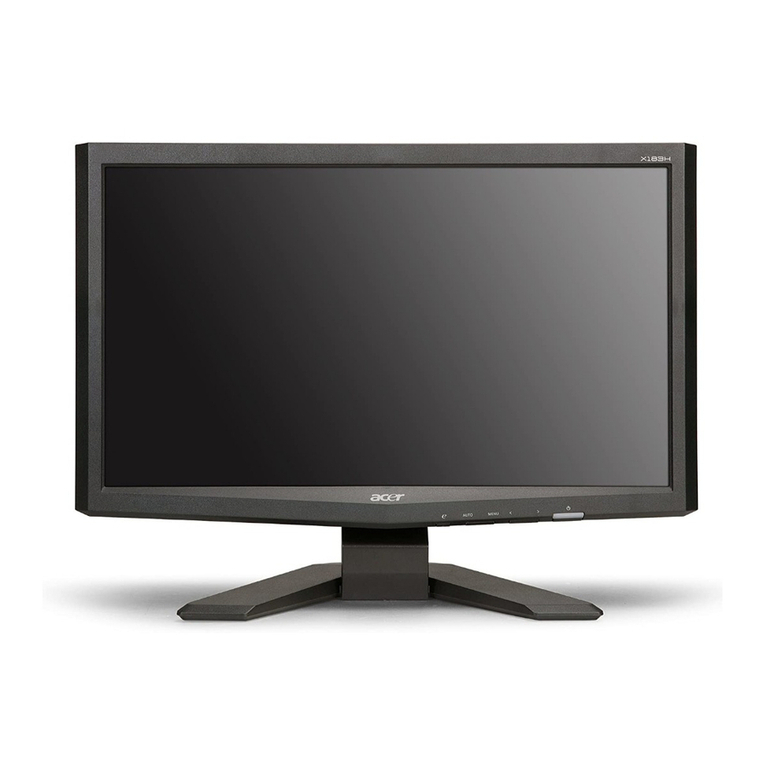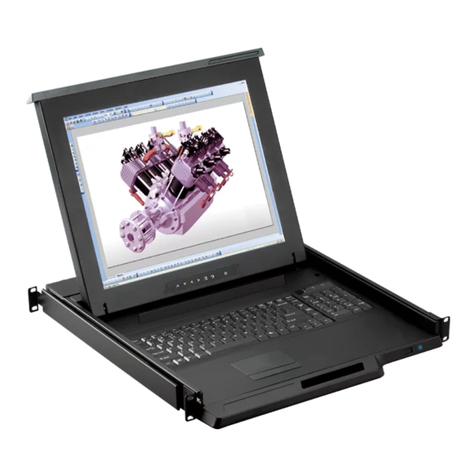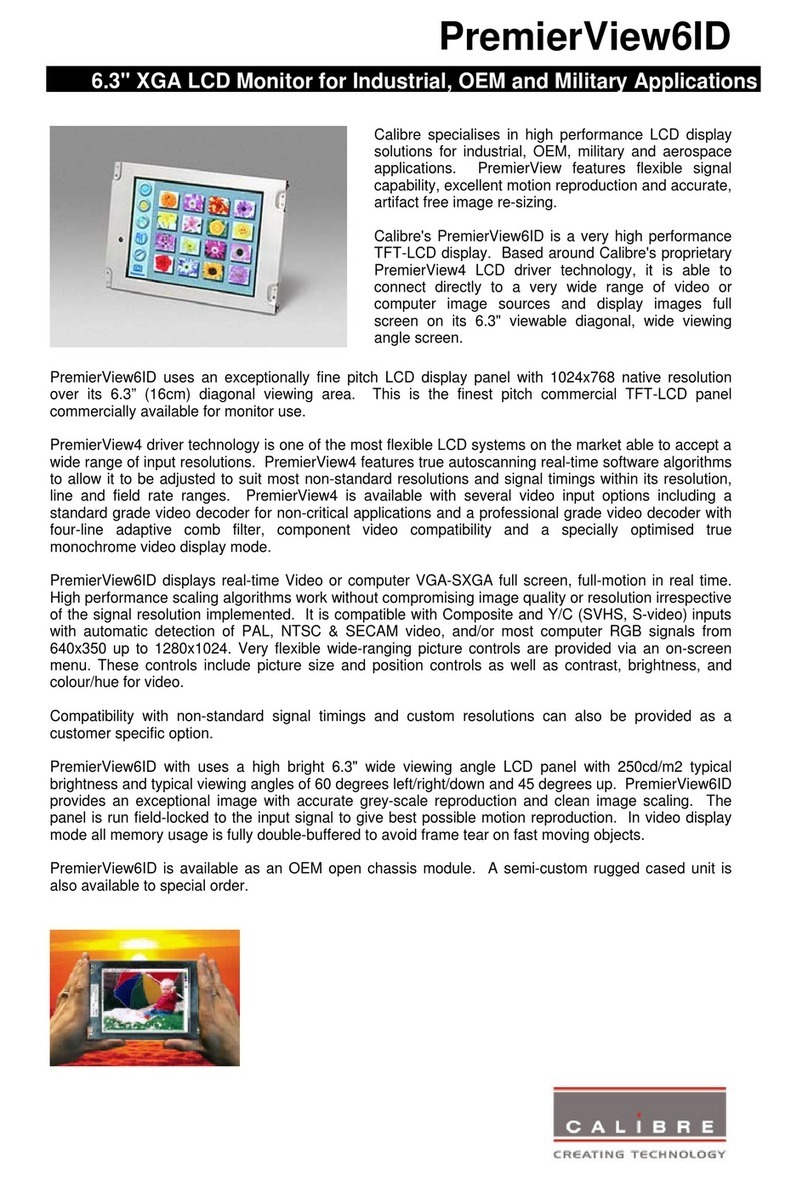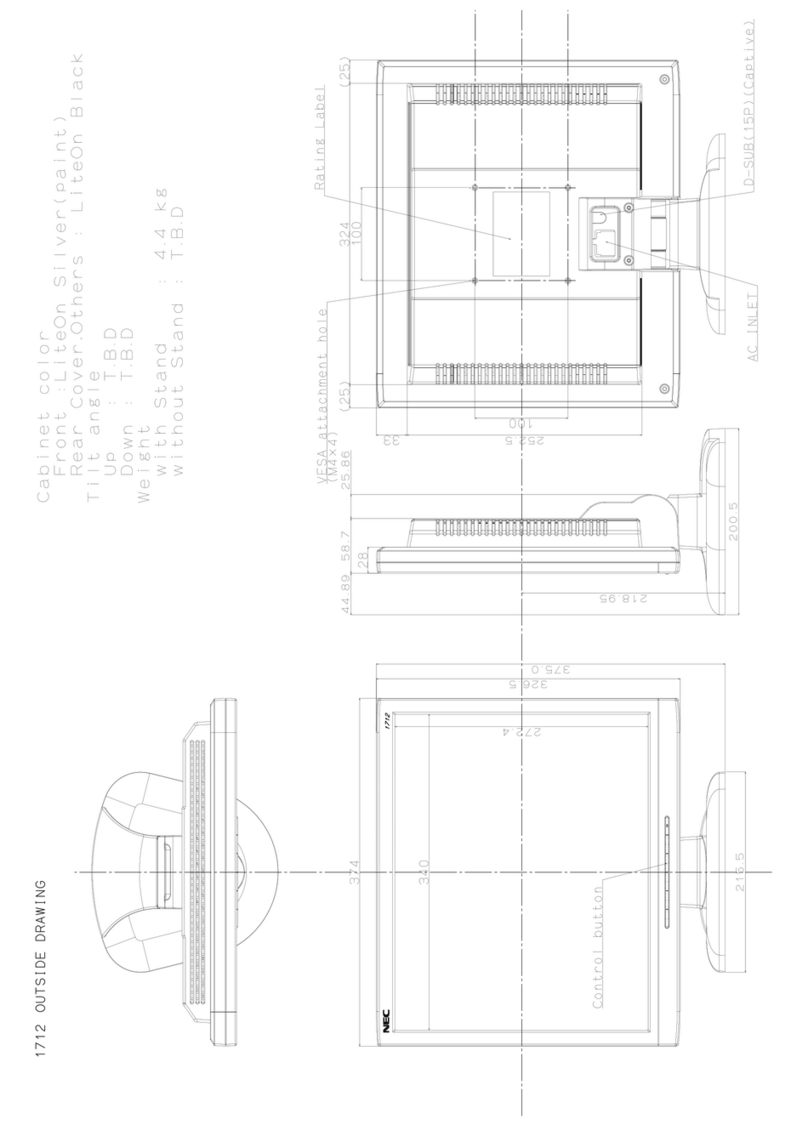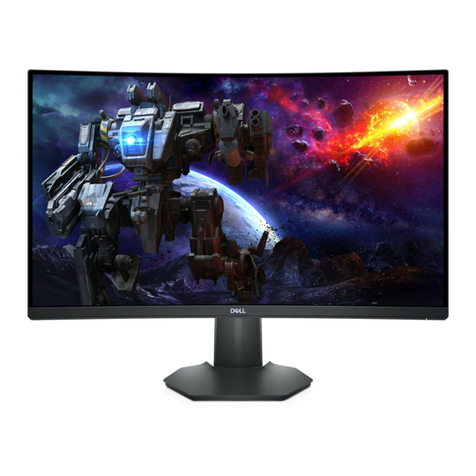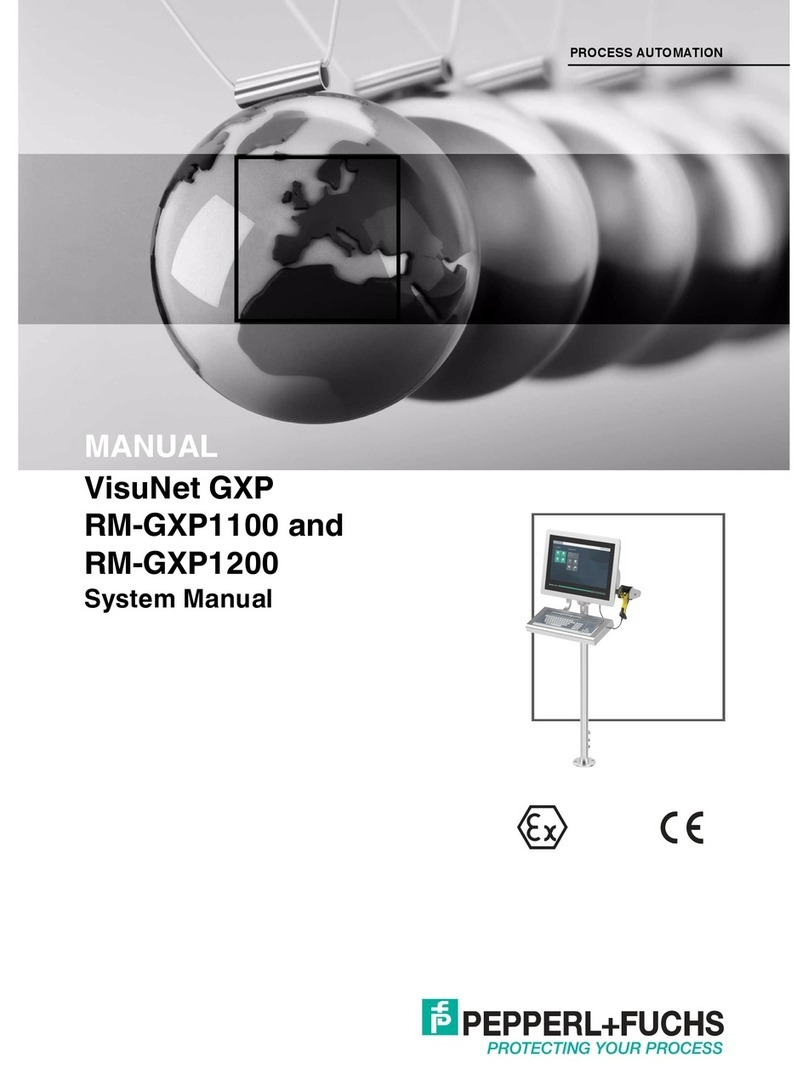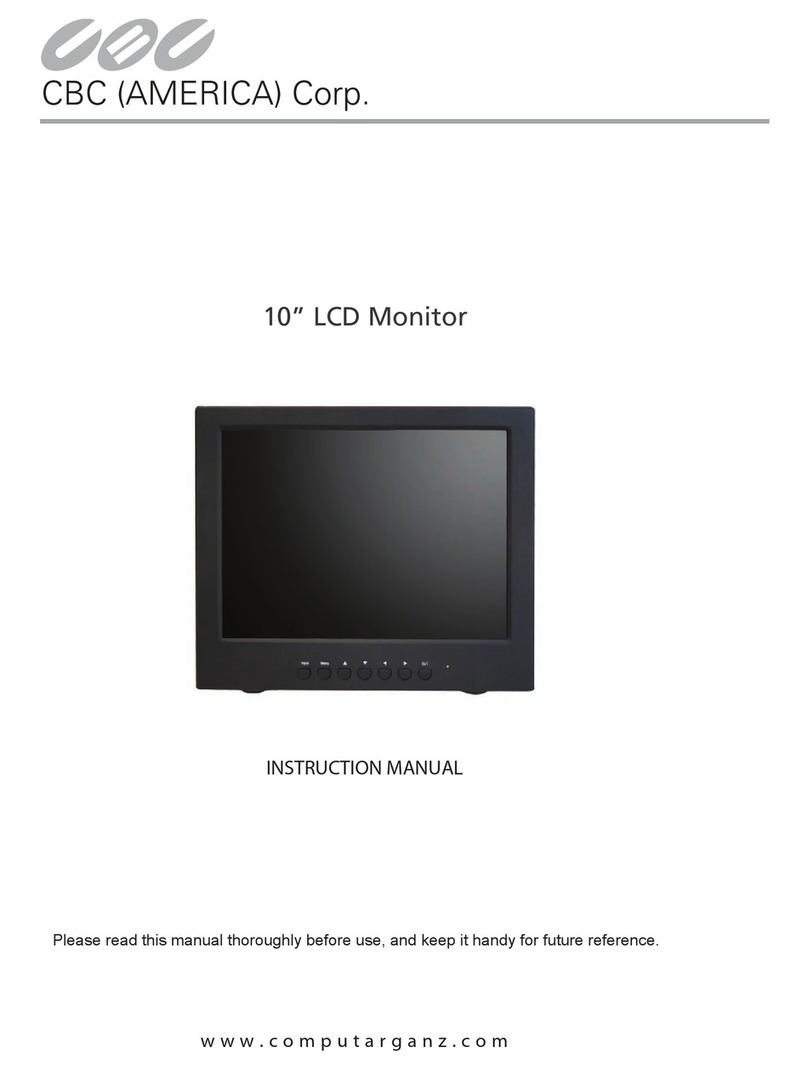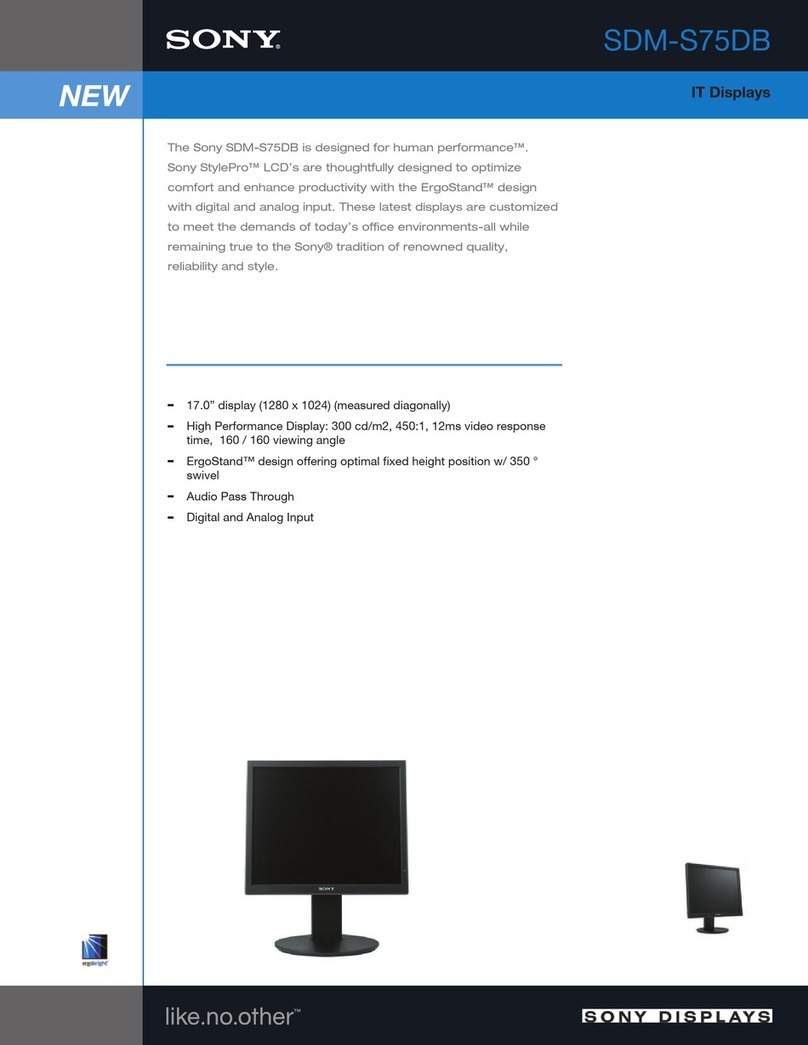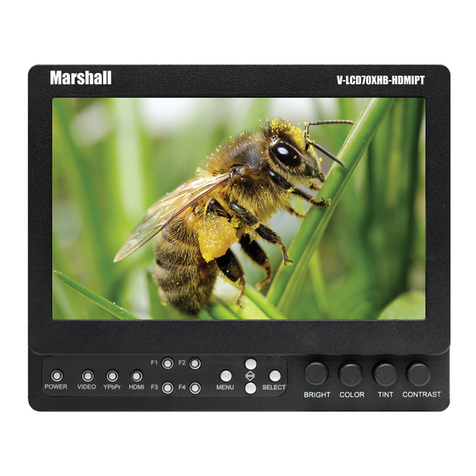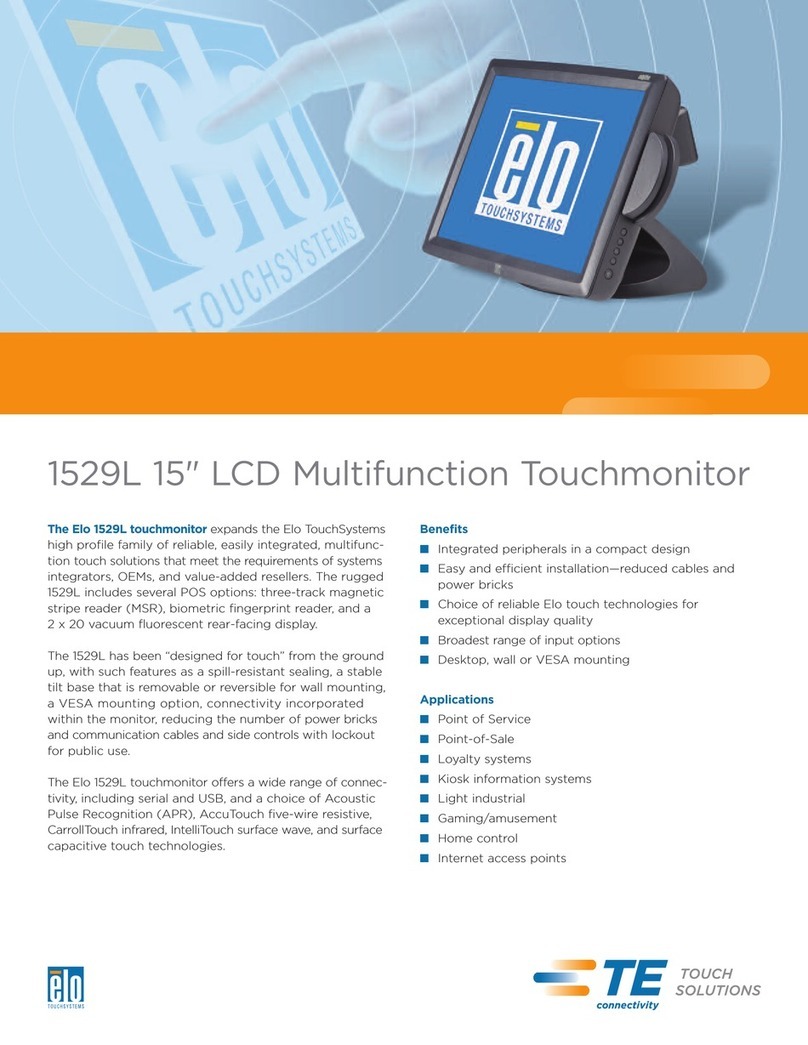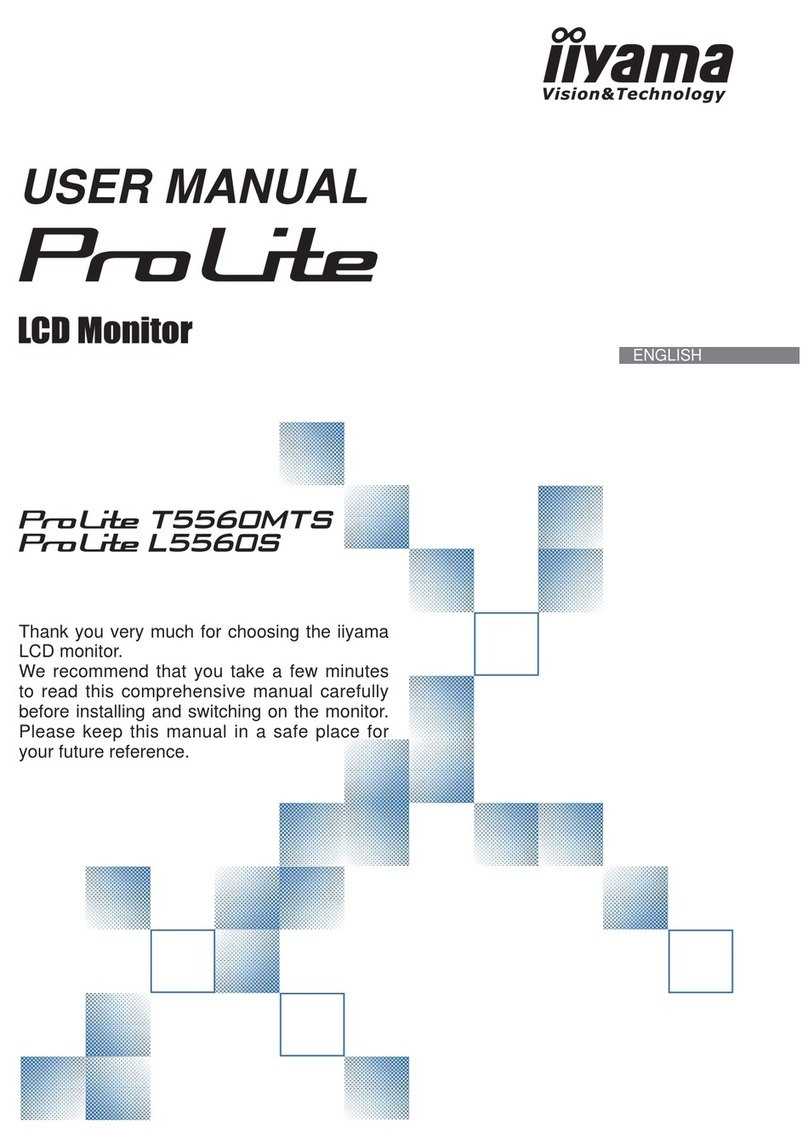Treetech TM1 User manual


Technical Manual –TM1/TM2 | MA-010| 2016-03-21 | Ver.: 6.30 2
Temperature Monitor
Table of contents
1FOREWORD.................................................................................................................................................... 6
1.1 LEGAL INFORMATION................................................................................................................................................ 6
1.2 PRESENTATION........................................................................................................................................................ 6
1.3 TYPOGRAPHICAL CONVENTIONS.................................................................................................................................. 6
1.4 GENERAL AND SAFETY INFORMATION........................................................................................................................... 6
Safety Symbols ..................................................................................................................................................... 7
General Symbols................................................................................................................................................... 7
Minimum profile recommended for the TM1/TM2 operator and maintainer ..................................................... 7
Environmental and voltage conditions required for installation and operation .................................................. 8
Instructions for test and installation .................................................................................................................... 8
Cleaning and decontamination instructions......................................................................................................... 9
Inspection and Maintenance instructions ............................................................................................................ 9
1.5 TECHNICAL ASSISTANCE .......................................................................................................................................... 10
1.6 WARRANTY TERM .................................................................................................................................................. 11
1.7 REVISION CONTROL................................................................................................................................................ 12
2INTRODUCTION.............................................................................................................................................13
2.1 MAIN FEATURES.................................................................................................................................................... 13
2.2 OPTIONAL FEATURES .............................................................................................................................................. 15
2.3 OPERATION PHILOSOPHY......................................................................................................................................... 16
3OPERATION...................................................................................................................................................19
3.1 INITIAL SETTINGS ................................................................................................................................................... 19
3.2 FUNCTION OF KEYS ................................................................................................................................................ 21
3.3 CONSULTATION SCREENS......................................................................................................................................... 21
TM1 Consultation Screens.................................................................................................................................. 21
Consultation Screen TM2 ................................................................................................................................... 23
3.4 COMMANDS ......................................................................................................................................................... 24
4PROJECT AND INSTALLATION ........................................................................................................................26
4.1 SYSTEM TOPOLOGY ................................................................................................................................................ 26
4.2 INPUTS AND OUTPUTS ............................................................................................................................................ 26
4.3 PROJECT AND INSTALLATION .................................................................................................................................... 28
RTD Temperature Sensors .................................................................................................................................. 29
Serial Communication Ports RS485 .................................................................................................................... 30
Analogic Outputs................................................................................................................................................ 31
Current Transformers ......................................................................................................................................... 31
Forced Cooling Control ....................................................................................................................................... 33
4.4 TYPICAL APPLICATION DIAGRAMS ............................................................................................................................. 41
4.5 MECHANICAL INSTALLATION .................................................................................................................................... 46
5PARAMETERIZATION.....................................................................................................................................47
5.1 PROGRAMMING .................................................................................................................................................... 47
5.2 ACCESS TO THE PROGRAMMING MENU...................................................................................................................... 48
5.3 ACCESS TO SUBMENUS ............................................................................................................................................ 49
Submenu LNG ..................................................................................................................................................... 50
Submenu CLK...................................................................................................................................................... 50
Submenu ALM .................................................................................................................................................... 51
Submenu CNF ..................................................................................................................................................... 53
Submenu TRF...................................................................................................................................................... 61

Technical Manual –TM1/TM2 | MA-010| 2016-03-21 | Ver.: 6.30 3
Temperature Monitor
Submenu FAN ..................................................................................................................................................... 65
Submenu LTC ...................................................................................................................................................... 69
Submenu LOG..................................................................................................................................................... 71
5.4 TYPICAL ADJUSTS ................................................................................................................................................... 73
6START-UP PROCEDURE FOR PUTTIN EQUIPMENT IN OPERATION .................................................................74
7TROUBLESHOOTING......................................................................................................................................80
7.1 THE DEVICE DISPLAYS SELF-DIAGNOSIS MESSAGES ON THE DISPLAY ................................................................................... 80
7.2 TM1/TM2 READS INCORRECT VALUES FOR TEMPERATURES........................................................................................... 87
7.3 TM1/TM2 READS INCORRECTLY VALUES FOR LOAD CURRENTS ....................................................................................... 88
7.4 TM1/TM2 INDICATES INCORRECT VALUES FOR WINDING TEMPERATURES ........................................................................ 88
7.5 TM1 DOES NOT COMMUNICATE WITH THE DATA ACQUISITION SYSTEM............................................................................. 88
7.6 REMOTE READING THROUGH ANALOG OUTPUT INCORRECT............................................................................................. 89
7.7 TM1/TM2 DOES NOT CORRECTLY ACTIVATE THE FORCED COOLING ................................................................................. 89
8ATTACHMENTS .............................................................................................................................................90
8.1 ATTACHMENT A .................................................................................................................................................... 90
8.2 ATTACHMENT B..................................................................................................................................................... 91
8.3 ATTACHMENT C..................................................................................................................................................... 92
8.4 ATTACHMENT D .................................................................................................................................................... 93

Technical Manual –TM1/TM2 | MA-010| 2016-03-21 | Ver.: 6.30 4
Temperature Monitor
List of figures
FIGURE 1–TEMPERATURE MONITORS TM1 AND TM2 ............................................................................................................... 14
FIGURE 2–TEMPERATURE MEASUREMENTS OF LTC, TRANSFORMER AND TEMPERATURE DIFFERENTIAL ................................................. 17
FIGURE 3-INSTANTANEOUS AND FILTERED TEMPERATURE DIFFERENTIALS ....................................................................................... 18
FIGURE 4–TEMPERATURE INDICATIONS .................................................................................................................................... 19
FIGURE 5–SIGNALING LEDS ON TEMPERATURE MONITOR TM1 ................................................................................................... 20
FIGURE 6–SIGNALING LEDS ON TEMPERATURE MONITOR TM2 ................................................................................................... 20
FIGURE 7–SELF-DIAGNOSTIC INDICATIONS ................................................................................................................................ 21
FIGURE 8–BLOCK DIAGRAM................................................................................................................................................... 26
FIGURE 9–DETAIL SHIELD CONNECTION OF RTD SENSOR ............................................................................................................ 30
FIGURE 10 –SHIELD CONNECTION OF SERIAL COMMUNICATION...................................................................................................... 31
FIGURE 11 –CONNECTION DETAILS OF CURRENT TRANSFORMERS DIRECTLY TEMPERATURE MONITORS .................................................. 32
FIGURE 12 –CONNECTION DETAILS OF CURRENT TRANSFORMERS TO TEMPERATURE MONITORS PREPARED FOR EXTERNAL CILIP-ON CTS...... 33
FIGURE 13 –COMMAND OF 4EQUAL FORCED COOLING GROUPS SHIFTING THE OPERATION OF GROUPS ................................................. 35
FIGURE 14 –COMMAND OF 1FORCED COOLING GROUP WITH PUMPS AND 3EQUAL GROUPS WITH FANS SHIFTING THE OPERATION OF FAN
GROPS ........................................................................................................................................................................ 36
FIGURE 15 –COMMAN OF 2EQUAL FORCED COOLING GROUPS WITH PUMPS AND 2EQUAL GROUPS WITH FANS,WITH INDEPENDENTE SHIFTING
FOR THE OPERATION OF THE PUMP GROUPS AND THE FAN GROUPS.......................................................................................... 37
FIGURE 16 –COMMAND OF 4EQUAL FORCED COOLING GROUPS IN 2TEMPERATURE STAGES,WITH TIMER FOR MOTORS START AND SHIFTING
THE GROUPS ................................................................................................................................................................ 39
FIGURE 17 –COMMAND OF 2EQUAL FORCED COOLING GROUPS WITH COMMAND REDUNDANCY ......................................................... 40
FIGURE 18 –OPTION 1–2RTDS WITH 3WIRES......................................................................................................................... 41
FIGURE 19 -OPTION 2–1RTD WITH 4WIRES .......................................................................................................................... 42
FIGURE 20 –OPTION 3–1RTD WITH 3WIRES,RTD A............................................................................................................... 43
FIGURE 21 –OPTION 4–1RTD WITH 3WIRES,RTD B............................................................................................................... 43
FIGURE 22 –CONNECTION TM1/TM2..................................................................................................................................... 44
FIGURE 23 –CONNECTION TM1 /MT2 ................................................................................................................................... 44
FIGURE 24 –CONNECTION MT1 /TM2 ................................................................................................................................... 45
FIGURE 25 –CONNECTION TM1 /SYNCHRONISM SIGNAL IRIG-B .................................................................................................. 45
FIGURE 26 –DIMENSIONS OF TM1 AND TM2 ........................................................................................................................... 46
FIGURE 27 –SELF-DIAGNOSTIC INDICATIONS .............................................................................................................................. 80

Technical Manual –TM1/TM2 | MA-010| 2016-03-21 | Ver.: 6.30 5
Temperature Monitor
List of Tables
TABLE 1–OPERATING CONDITIONS ............................................................................................................................................ 8
TABLE 2–REVISION CONTROL ................................................................................................................................................. 12
TABLE 3–TM1/TM2 INPUTS................................................................................................................................................. 27
TABLE 4-TM1/TM2 OUTPUTS............................................................................................................................................... 28
TABLE 6–DIGIT 1FAILURES .................................................................................................................................................... 81
TABLE 7–DIGIT 2FAILURES.................................................................................................................................................... 82
TABLE 8–DIGIT 3FAILURES.................................................................................................................................................... 84
TABLE 9–DIGIT 4FAILURES .................................................................................................................................................... 86
TABLE 10 –INCORRECT READING OF VALUES FOR TEMPERATURES ................................................................................................... 87
TABLE 11 –INCORRECTLY VALUES FOR LOAD CURRENTS ................................................................................................................ 88
TABLE 12 –INCORRECT VALUES FOR WINDING TEMPERATURES....................................................................................................... 88
TABLE 13 –NO COMMUNICATION BETWEEN TM1 AND DATA ACQUISITION SYSTEM.......................................................................... 88
TABLE 14 –REMOTE READING THROUGH ANALOG OUTPUT INCORRECT ............................................................................................ 89
TABLE 15 -INCORRECT ACTIVATE THE FORCED COOLING ................................................................................................................ 89
TABLE 16 –COMPATIBILITY BETWEEN FIRMWARES....................................................................................................................... 93

Technical Manual –TM1/TM2 | MA-010| 2016-03-21 | Ver.: 6.30 6
Temperature Monitor
1Foreword
1.1 Legal Information
The information contained in this document is subject to changes without prior notice.
This document belongs to Treetech Sistemas Digitais Ltda. and may neither be copied,
transferred to third parties nor used without express authorization, in terms of law 9.610/98.
Disclaimer:
Treetech Sistemas Digitais reserves the right to make changes without prior notice in all
products, circuits and functionalities described herein with the aim of improving their
reliability, function or design. Treetech Sistemas Digitais does not assume any liability resulting
from application or use of any product or circuit described herein, and does not transmit any
licenses or patents under its rights, not even third party rights.
Treetech Sistemas Digitais Ltda. may own patent or other types of registrations and intellectual
property rights described in the content of this document. Possession of this document by any
person or entity does not give such person or entity any right over these patents or
registrations.
1.2 Presentation
This manual presents all the recommendations and instructions for installation, operation and
maintenance of the Temperature Monitor –TM1/TM2.
1.3 Typographical Conventions
Throughout this text, the following typographical conventions were adopted:
Bold: Symbols, terms and words that are in bold have greater contextual importance.
Therefore, pay attention to these terms.
Italics: Terms in foreign language, alternative or with their use outside the formal situation are
written in italics.
1.4 General and Safety Information
This section presents relevant aspects of safety, installation and maintenance of the TM1/TM2.

Technical Manual –TM1/TM2 | MA-010| 2016-03-21 | Ver.: 6.30 7
Temperature Monitor
Safety Symbols
This manual uses three types of risk classification, as shown below:
Caution
The Caution symbol is used to alert the user of a potentially hazardous operating or maintenance
procedure that demands greater caution in its conduction. There may be minor or moderate injuries, as
well as damages to the equipment.
Warning
The Warning symbol is used to alert the user of a potentially hazardous operating or maintenance
procedure in which extreme caution must be taken. There may be serious injuries or death. Possible
damages to the equipment are irreparable.
Electric Shock Hazard
The Electric Shock Hazard symbol is used to alert the user of an operating or maintenance procedure
that may result in electric shock if not strictly observed. There may be minor, moderate, serious injuries
or death.
General Symbols
This manual uses the following general symbols:
Important
The Important symbol is used to highlight relevant information.
Tip:
The Tip symbol represents instructions that facilitate use and access of functions in the TM1/TM2.
Minimum profile recommended for the TM1/TM2 operator and maintainer
Installation, maintenance and operation of equipment in electric power substations require
special cares and, therefore, all recommendations of this manual, applicable standards, safety
procedures, safe work practices and good judgment must be used during all handling stages of
the Temperature Monitor (TM1 and TM2).
For use of this manual, an authorized and trained person has knowledge of the inherent risks –
both electrical and environmental –involved in handling the TM1 and TM2.
Only authorized and trained personnel –operators and maintainers –should handle this equipment.

Technical Manual –TM1/TM2 | MA-010| 2016-03-21 | Ver.: 6.30 8
Temperature Monitor
a) The operator or maintainer must be trained and authorized to operate,
ground, turn on and turn off the TM1/TM2, following maintenance procedures
according to the safety practices established, under the sole responsibility of the
TM1/TM2 operator and maintainer;
b) Be trained in the use of IPEs, CPEs and first-aid;
c) Trained in the working principles of the TM1 and TM2, as well as its
configuration.
d) Follow regulatory recommendations regarding interventions in any type of
equipment included in an Electric Power System.
Environmental and voltage conditions required for installation and operation
The table below lists important information on the environmental and voltage requirements:
Table 1 –Operating Conditions
Condition
Interval/Description
Application
Equipment for sheltered use in substations, industrial
environments and similar.
Internal/External Use
Internal Use
Degree of Protection (IEC 60529)
IP 20
Altitude* (IEC EN 61010-1)
Up to 2000 m
Temperature (IEC EN 61010-1)
Operation
-40 °C to +85 °C
Storage
-50 °C to +95 °C
Relative Humidity (IEC EN 61010-1)
Operation
5% to 95% –Uncondensed
Storage
3% to 98% –Uncondensed
MAINS Supply Voltage Fluctuation (IEC EN 61010-1)
Up to ±10% of the Rated voltage
Overvoltage (IEC EN 61010-1)
Category II
Level of Pollution (IEC EN 61010-1)
Level 2
Atmospheric Pressure** (IEC EN 61010-1)
80 kPa to 110 kPa
* Altitudes greater than 2000 m already have successful applications.
* Pressures of less than 80 kPa already have successful applications.
Instructions for test and installation
This manual must be available to those responsible for installation, maintenance and users
of the Temperature Monitor –TM1/TM2.
To guarantee user safety, equipment protection and correct operation, the following minimum
cares must be followed during the TM1/TM2 installation and maintenance:
1. Read this manual carefully before installation, operation and maintenance of
the TM1/TM2. Errors in installation, maintenance or adjustments of the TM1/TM2

Technical Manual –TM1/TM2 | MA-010| 2016-03-21 | Ver.: 6.30 9
Temperature Monitor
can cause undue operations of the tap changer in load, unsatisfactory voltage
regulation, undue alarms or pertinent alarms may also fail to be emitted.
2. The installation, adjustments and operation of the TM1/TM2 must be done by
personnel trained and acquainted with the electric motors, power transformers,
tap changers on load or voltage regulators, control devices and control circuits of
substation equipment.
3. Special attention must be paid to installation of the TM1/TM2, including the
type and size of the cables and terminal strips used, as well as the procedures
for commissioning, including correct parameterization of the equipment.
The TM1/TM2 must be installed in a sheltered environment (a panel without doors in a control room or
in a closed panel, in cases of outdoor installation) where the temperature and humidity specified for the
equipment are not exceeded.
Do not install the TM1/TM2 near sources of heat like heat resistors, incandescent lamps and devices
with high power or with heat dissipaters. Its installation near ventilation orifices or where it can be
affected by forced air flow, like outlet or inlet of cooling fans or forced ventilation ducts, is not
recommended.
On conducting dielectric strength tests on the wiring (applied voltage), the ground cables connected to
terminal 17 of the TM1/TM2 must be disconnected in order to prevent destruction of the protections
against overvoltage existing inside the device due to application of high voltages for a long period (e.g.:
2 kV for 1 minute).
Cleaning and decontamination instructions
Take care when cleaning the TM1/TM2. Use ONLY a cloth wet with soap or detergent diluted
in water to clean the cabinet, front plate or any other part of the equipment. Do not use
abrasive materials, polishers or aggressive chemical solvents (like alcohol or acetone) on any of
its surfaces.
Turn off and unplug the equipment before cleaning any of its parts.
Inspection and Maintenance instructions
The following observations must be followed for inspection and maintenance of the TM1/TM2:
If the panel where the TM1 / TM2 was installed has a window , use a G20 film - or higher - to avoid
direct incidence of sunlight ( UV ) at the equipment . Even if the glass of this window is dark, such
procedure is necessary.

Technical Manual –TM1/TM2 | MA-010| 2016-03-21 | Ver.: 6.30 10
Temperature Monitor
Do not open the equipment. In it, there are no parts reparable by the user. This should be done by the
Treetech technical assistance, or by technicians accredited by it.
This equipment is completely maintenance-free, being that visual and operational inspections,
periodical or not, may be conducted by the user. These inspections are not mandatory.
Opening of the TM1/TM2 at any time will imply in loss of the product warranty. In cases of undue
opening of the equipment, Treetech will also not be able to warrant its correct functioning, regardless of
the warranty period having expired or not.
All parts of this equipment must be supplied by Treetech, or by one of its accredited suppliers,
according to its specifications. If the user wishes to purchase it otherwise, he must strictly follow
Treetech’s recommendations for this. This way, the performance and safety for the user and the
equipment will not be compromised. If these specifications are not followed, the user and the
equipment may be exposed to unforeseen and unnecessary risks.
1.5 Technical Assistance
To obtain technical assistance for the TM1/TM2 or any other Treetech product, contact us
through the address below:
Treetech Sistemas Digitais Ltda. –Assistência Técnica
Rua José Alvim, 100 –Salas 03 e 04 –Centro
Atibaia –São Paulo –Brazil
Zip Code: 12940-800
CNPJ [Corporate taxpayer's roll]: 74.211.970/0002-53
IE [State Tax ID]: 190.159.742.110
PHONE: +55 (11) 2410-1190 x201
FAX: +55 (11) 2410-1190 x702
Email: suporte.tecnico@treetech.com.br
Site: http://www.treetech.com.br

Technical Manual –TM1/TM2 | MA-010| 2016-03-21 | Ver.: 6.30 11
Temperature Monitor
1.6 Warranty term
The Temperature Monitor is guaranteed by Treetech for the term of 2 (two) years, counted
from the date of purchase, exclusively against eventual manufacture defects or quality vices
that render the equipment unfit for use.
The warranty will not cover damages sustained by the product, as a consequence of accidents,
improper handling, incorrect installation and use, inadequate tests or in case the warranty seal
has been breached.
The eventual need for technical assistance must be informed to TREETECH, or to a technical
assistance service appointed by the same, with the equipment being delivered together with
the purchase invoice.
Treetech does not supply, nor is liable to, any other warranty, express or understood, in
addition to the ones mentioned above. Treetech does not supply any guarantee of suitability
of the TM1/TM2 to any specific application.
The dealer is not liable to any claims for damage to property, nor any other form of losses that
might occur, in connection to or stemming from the acquisition of the equipment, of the
performance of the equipment or of any other service possibly supplied together with the
TM1/TM2.
Under no circumstances will the dealer be made responsible for any losses incurred, included
but not limited to: loss of profit or revenue, impossibility in using the TM1/TM2 or any other
associated item of equipment, costs of capital, costs of energy acquired, costs of replacement
equipment, facilities or services, costs of outages, complaints from clients or employees of the
buyer, regardless of whether said damages, complaints or losses are based on contracts,
warranties, negligence, felony or any other reason.
Under no circumstances can the dealer be made liable for any personal damage of any sort.

Technical Manual –TM1/TM2 | MA-010| 2016-03-21 | Ver.: 6.30 12
Temperature Monitor
1.7 Revision Control
Table 2 –Revision Control
Revision
Issued
Description
Author
2
2004-11-11
Add submenu PRT (serial communication protocol selection)
and review control page. General text revision.
Note: This manual version is applied just for Temperature
Monitor with firmware V2.0.2
Fco
3
2004-12-08
Included optional functions of forced cooling, clock and
calendar, DNP3.0 information.
Note: This manual version is applied just for Temperature
Monitor with firmware V2.0.4
Fco
4
2005-07-15
Setting range of TRC parameter changed (chapters 5.3.4.1
and 5.3.4.2). Added Modbus registers 67...72.
Note: This manual version is applicable only to Temperature
Monitor with firmware V2.0.7 and higher (unless a specific
manual version is available)
Marcos
5
2006-10-31
Recommendations for insulation tests and parameter sheets
included. Revised temperature scale, register maps and
troubleshooting. General text revision.
Note: This manual version is applicable only to Temperature
Monitor with firmware V3.0.0 and higher (unless a specific
manual version is available)
Marcos
6
2007-06-01
Optional functions Mass Memory and LTC Temperature
Differential included.
Note: This manual version is applicable only to Temperature
Monitor with firmware V4.0.0 and higher (unless a specific
manual version is available)
Marcos
7
2008-04-14
Revised DNP3.0 Device Profile –Analog Inputs 42-49 and
Binary Inputs 64-71 included.
Revised Modbus Register Map –registers 1025-1031, 1505
and 1506 included. Added figures 4.4.and 4.5.
Note: This manual version is applicable only to Temperature
Monitor with firmware V4.0.3 and higher (unless a specific
manual version is available)
Marcos
8
2008-07-15
Revised Forced Cooling control, chapters 2.2, 3.1, 3.4, 4.1,
4.2, 4.2.4, 4.3, 5.3, 5.3.5, 5.3.5.1, 5.3.5.2, 7.7 and Apendix D.
Note: This manual version is applicable only to Temperature
Monitor with firmware V4.0.5 and higher (unless a specific
manual version is available)
Marcos
9
2013-01-15
Aditional functions PBT, SCT, BG1...BG4 included.
Some menus were divided in submenus.
Note: This manual version is applicable only to Temperature
Monitor with firmware V5.0.0 and higher (unless a specific
manual version is available)
William Botelho
10
2015-05-21
International Representatives updated
João V. Miranda
11
2015-07-06
New design; parameterization updated; compatible with 4.16
firmware.
João V. Miranda
12
2015-09-17
Procedure for film installation added
João V. Miranda
13
2016-01-20
Figure 26 (Dimensions) Updated
João V. Miranda
14
2016-03-21
Connection Diagram Updated
João V. Miranda

Technical Manual –TM1/TM2 | MA-010| 2016-03-21 | Ver.: 6.30 13
Temperature Monitor
2Introduction
The Treetech's TM Temperature Monitors form a complete Temperature Monitoring system
for transformers and reactors immersed in oil. Designed as a modular system, it can be used in
simple, low cost applications, as well as in complete monitoring systems. The system is
comprised of modules TM1 and TM2:
TM1 monitors the temperature of the oil and one winding. The device is equipped
with:
-Configurable input for one 4-lead RTD sensor, for oil temperature, or two 3-lead
sensors - redundant reading of oil temperature or simple reading for oil
temperature and one additional temperature (e.g.: ambient or LTC);
- One load current measuring input, for calculating temperature of the winding.
TM2, applied as complement to TM1, monitors the temperature of one or two
additional windings. It is equipped with:
- Two current measuring inputs, for calculating the temperature of two additional
windings;
- Configurable input for one 4-lead RTD sensor, one 3-lead RTD sensor in input A,
one 3-lead RTD sensor in input B or two 3-lead sensors in inputs A and B for
reading additional temperatures (e.g.: ambient, LTCs or others).
Além destas funções básicas, estão disponíveis nos monitores TM1 e TM2 diversos opcionais.
Vide Funções Opcionais adiante.
2.1 Main Features
Input for Pt100 ohms at 0ºC sensors with self-calibration, precision of 0.2% of the end of
scale and high level of stability in a broad range of ambient temperatures.
Oil temperature measurement using one three-wire Pt100 sensor, one four wire Pt100
or two three-wire Pt100 (redundant temperature measurement and validation of the
reading);
Universal AC current inputs True RMS from 0 to 10A, precision 0.5% of full scale for load
measurement and calculation of temperature in the winding through the thermal image
process. Optional clip-on current transformers;
High luminosity, LED type displays for easy visualization, indicating oil, winding and
other user selected temperatures;

Technical Manual –TM1/TM2 | MA-010| 2016-03-21 | Ver.: 6.30 14
Temperature Monitor
Calculation of forecast for final oil-winding temperature gradient for current load
condition;
Current outputs for remote temperature readings, with selection of output range
(0...1mA, 0...5mA, 0...10mA, 0...20mA or 4...20mA);
Selectable cooling system operation via front panel on Automatic or Manual. Automatic
alternation in operation of forced cooling groups in pre-programmed stages, based on
their operation times , affording uniform use of fans or pumps;
Optional Pre-cooling function for reducing insulation loss of life due to elevated loads;
Optional Fan Exercise function for prevention of failures in cooling fans or pumps;
NO contacts (NC or combinations upon request) for oil or winding temperature alarms;
NO contacts (NC or combinations upon request) for tripping due to oil and/or winding
temperatures with double activation safety (simultaneous order from the 2 micro-
controllers for the operation). Adjustable timing between 0 and 20 min with countdown
on display;
NC contacts for activation of forced cooling groups with timer between start up for
groups (even with lack of feed for TM1 or TM2) and forced operation resulting from self-
diagnosis routines in case of failure or absence of voltage (power outage);
NC contacts for indication of internal failure or lack of voltage detected in self-diagnosis;
NO contacts for indication of count down mode for trip activation or alarm by LTC
temperature differential;
Modbus-RTU (standard) or DNP 3.0 (optional) serial communication protocols.
Protocol DNP-3.0 (optional) with time stamp with 1ms resolution for events like alarms
and trips, based on synchronicity by GPS signal clock on standard IRIG-B (only for TM1)
or synchronicity by the protocol DNP3.0;
Non volatile mass memory for storage of temperature readings, alarm or trip events and
forced cooling operation;
Internal clock with settings maintained for 48h in case of failure of power supply. No
batteries are used - maintenance-free device.
Figure 1 –Temperature Monitors TM1 and TM2

Technical Manual –TM1/TM2 | MA-010| 2016-03-21 | Ver.: 6.30 15
Temperature Monitor
2.2 Optional Features
According to the order, the TM1/TM2 can be supplied with one or more of the optional
features listed below:
Optional 1 –DNP 3.0 protocol:
User selectable communication protocol: Modbus RTU or DNP3.0 level 1. DNP3.0 protocol with
support for 1ms resolution time-stamp.
Optional 2 –Pre-Cooling:
Pre-cooling can extend the insulation useful life of transformers subject to overloading by
activating cooling groups when user selected load levels are reached. Taking advantage of the
large thermal inertia of the oil, the forced cooling systems are activated even before the
temperature rises, thus increasing the time required to reach high temperature levels, which
would cause accelerated shortening of insulation life cycle. The following parameters are
programmed by users:
Loading percentages for individual activation of up to four cooling stages;
Hysteresis for shut off of forced cooling stages in case of load reduction.
Optional 3 –Fan and Pump Exercise:
The fan exercise function keeps fans and / or pumps from remaining inactive for prolonged
periods of time in transformers operating under low load conditions or during periods of low
ambient temperatures. This avoids axle blocking due to accumulation of dirt, grease dry out or
bird nesting. Fans are switched on every day, based on the equipment's internal clock and
depending on selections made by users:
Hour and minute for start up of fans and/or pumps;
Total daily fan and/or pump operation time, from 0 to 999 minutes.
Optional 4 –Temperature Differential for the Load Tap Changer:
Load Tap Changers are one of the main sources of transformer failure. Measuring the
temperature difference between the LTC oil and transformer oil may give an indication of a
thermal failure event in the equipment before reaching a level of severity that could lead to a
major failure. Since this difference is subject to the influence of external variables, monitoring
is carried out in two different ways, in order to increase efficiency of diagnosis and avoid false
alarms:
Monitoring of instant difference triggers fast response alarms, in case of high intensity
defects, even in case of short duration events;
Monitoring of difference with long term filter triggers alarms sensitive to permanent
defects, even in case of low intensity, with longer detection times.

Technical Manual –TM1/TM2 | MA-010| 2016-03-21 | Ver.: 6.30 16
Temperature Monitor
In three-phase transformers using three single-phase tap changers in separate oil chambers
the three temperature differences can be monitored separately.
Optional 5 –Mass Memory:
Nonvolatile memory for storage of temperature readings and alarm events. Users select
variable groups to store and save to memory. Recording operation can be started by:
Time interval between storage of readings selected by user; or
Variation of temperature higher than any dead band selected by the user, in ºC; or
Change of state in any output relay (control of cooling, alarms, trips or self-diagnostic).
2.3 Operation Philosophy
OIL AND WINDING TEMPERATURES
Based on the readings obtained for the top oil temperature and the load current on the
transformer, the temperature monitor calculates the winding temperature by way of the
algorithm implemented in its firmware (thermal image). Other data items are part of this
algorithm. These other items are programmed in the device by the user, thus adapting the
model to each transformer’s characteristics.
transformer load current measurement is carried out through the secondary of one or more
current transformers (CTs) connected directly to the TM1 and TM2 or through external clip-on
CTs (optional delivery).
FORCED COOLING CONTROL
Temperature Monitors TM1 and TM2 can command up to 4 forced cooling groups, either in
manual or automatic mode. In automatic mode, the control of forced cooling groups is always
accomplished based in the higher value measured among oil and 1, 2, and 3 winding
temperatures. If the optional pre-cooling function is available, forced cooling can also be
commanded based on percentage load of windings, considering the highest measured load.
Due to oil and windings thermal inertia, pre-cooling function causes the cooling groups to be
activated before transformer achieve the temperature levels preset in automatic command
settings, thus reducing the average transformer operating temperature.
Optional function of cooling equipment exercise allows daily activation of fans and/or oil
circulation pumps in order to prevent mechanical failures caused by long periods out of
service, with user-defined starting time and duration.
LTC TEMPERATURE DIFERENTIAL

Technical Manual –TM1/TM2 | MA-010| 2016-03-21 | Ver.: 6.30 17
Temperature Monitor
The Load Tap Changer (LTC) is one of the principal sources of failure in power transformers,
arising mainly from the existence of moving parts that conduct and interrupt high currents
while submitted to high electrical potentials.
Some of the most common of these tap changer failure modes are related to the contact
deterioration or mechanical wear and tear that give rise to increase in the contact resistance
and which in turn raises the temperature significantly and then tends to increase even more
the resistance, a cascading effect that leads to complete, severe failure.
Under normal operating conditions, the LTC is a small source of heat compared to the heat
generated by the losses of the transformer, in the way that oil temperature in the LTC tank is
influenced principally by the transformer’s oil temperature. Illustration below, elaborated by
real measurements in the field, exemplifies this situation. In it we can observe, as well as the
individual transformer and tap changer temperatures, the difference between the LTC
temperatures minus the transformer’s, which is monitored to detect the faults mentioned
above.
Figure 2 –Temperature measurements of LTC, transformer and temperature differential
As the temperature differential is subject to the influence of external variables, such as the
action of forced cooling, rapid variations in atmospheric conditions and others, monitoring is
carried out by two distinct modes, illustrated in next figure, in order to increase diagnostic
efficiency and avoid false alarms:
Instantaneous Differential Monitoring - the Instantaneous Temperature Differential
monitoring triggers alarms with a rapid response in case there are large-scale faults,
even if they have short duration.
Monitoring of Filtered Differential - the Filtered Temperature Differential is obtained
by submitting the Instantaneous Differential to a low-pass filter with user adjustable
time-constant. Its monitoring enables the detection of the evolutionary trend of a
differential which indicates small permanent defects, over a longer period of
detection.
-10
0
10
20
30
40
50
60
28/8/2002
00:00:00 30/8/2002
00:00:00 1/9/2002
00:00:00 3/9/2002
00:00:00 5/9/2002
00:00:00 7/9/2002
00:00:00
TRANSFORMER OIL (ºC)
LTC OIL (ºC)
DIFFERENCE LTC-TRANSFORMER (ºC)

Technical Manual –TM1/TM2 | MA-010| 2016-03-21 | Ver.: 6.30 18
Temperature Monitor
Figure 3 - Instantaneous and Filtered Temperature Differentials
The alarm settings to the monitoring of the Instantaneous and Filtered differentials can be
automatically determined by the Temperature Monitor, through a learning period about the
normal behavior of the LTC. The automatic alarm settings can be manually changed by user.
The duration of the learning period can be programmed by user. Typical value is one week.
During this period the Temperature Monitor will register the peak values for the Instantaneous
and Filtered Differentials. After that the alarm settings for both temperature differentials are
obtained by summing the peak values to a programmed tolerance margin.
If the measured temperature differentials, either Instantaneous or Filtered, exceed their
respective alarm settings the Temperature Monitor will trigger an alarm. This alarm is
indicated by a LED lamp on the device’s front panel and can operate the output contact A1-A2
on TM1 and/or TM2, provided these contacts are programmed by user in this way.
The measurements of transformer top oil temperature and load tap changer oil temperature
are performed by Pt100Ω@0ºC sensors, which are connected to the inputs available on
Temperature Monitors TM1 and TM2. TM1 has 2 temperature sensor inputs; at least one of
them must be used for transformer top oil temperature, the other one can be used for
redundant top oil measurement or for LTC, ambient or other temperatures. TM2 has 2
additional inputs available for LTC temperature, ambient temperature or others.
-8
-4
0
4
INSTANTANEOUS DIFFERENTIAL (ºC)
FILTERED DIFFERENTIAL (ºC)

Technical Manual –TM1/TM2 | MA-010| 2016-03-21 | Ver.: 6.30 19
Temperature Monitor
3Operation
All operations on the Temperature Monitors TM1 and TM2 are performed through the
keyboard on the front panel, without the need for any external selector switches. The
temperature of the oil, winding (or windings) and Load Tap Changer are shown on the displays,
and the alarm status, trips and forced cooling commands are indicated by the signal LEDs.
3.1 Initial Settings
During normal work mode, the Temperature Monitor will display the temperatures of the
oil and winding (or windings) connected to the equipment.
When the value programmed for an event is reached, the corresponding signal LED will light
up, and activate the output contact for this event.
Winding 1
Temperature
Teclas de operação e
programação
Signaling
Leds
Oil
Temperature
Operation and
programming buttons
Winding 2
Temperature
Winding 3
Temperature
Figure 4 –Temperature Indications

Technical Manual –TM1/TM2 | MA-010| 2016-03-21 | Ver.: 6.30 20
Temperature Monitor
Figure 5 –Signaling LEDs on Temperature Monitor TM1
Figure 6 –Signaling LEDs on Temperature Monitor TM2
In case any abnormality occurs, the corresponding self-diagnostic code will be shown on the
displays.
If selected the PTA or PTB option in the DSP parameter of TM2, the LED indicating the presentation of
this temperature instead of winding temperature 3 - which is the standard indication - lights on the front
of TM2. This is the signal for the display mode of the lower display, DSP parameter TM2.
Oil Temperature
Alarm / Trip
Status of forced cooling groups 1
and 2
Load Tap Changer
Temperature Differential
Alarm (optional)
Winding 1 Temperature
Alarm / Trip
Winding 3 Temperature
Alarm / Trip
Winding 2 Temperature
Alarm / Trip
Forced Cooling Groups 1 and 2
(redundant) or 3 and 4 status
Status
Indication mode of lower display: ambient
temperature (LED lit) or winding 3 temperature
(LED unlit)
This manual suits for next models
1
Table of contents
Other Treetech Monitor manuals
